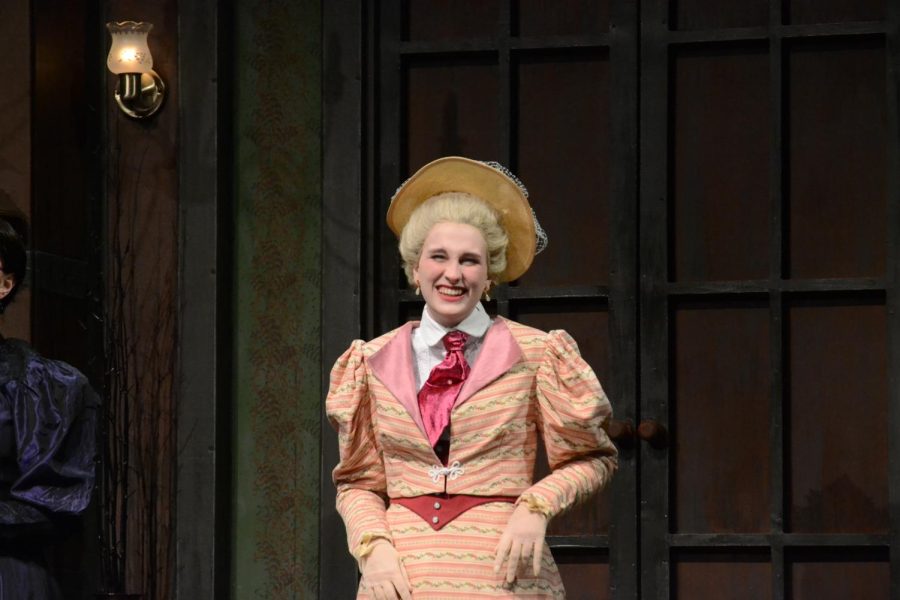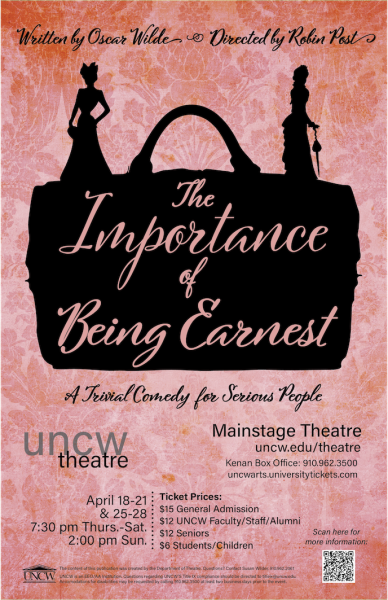REVIEW: UNCW’s ‘The Moors’ mixes 19th century Brontë class and comedy with Hitchcock’s horror and suspense
April 8, 2022
Set on the dreary, haunting moors of England, this story features a twisting roller-coaster ride of events and secrets that cannot help but pull the audience in, only to keep them in the dark. Early uncertainty in the show is reminiscent of Hitchcock’s mysteries such as Rebecca, with all the beauty, class and attitude of society women in Brontë’s classic novel Jane Eyre.
The English moors are an other-worldly place brought to life by a set designed by Randall A. Enlow, an associate professor at UNCW specializing in scenic and lighting design, that is stuck in a time loop. Projections on the back wall and sounds of rainfall, thunder, lightning and wind create this prison and a sense of entrapment in a lifestyle these characters have no way of escaping. Period costumes and a set painted to resemble an old English manor set the time period, while the jokes and introspective dialogue present the characters in a way that proves there is more going on here than can be seen. Some of the truth may be a mystery to the actors as well as the audience.
In the opening scene, a governess named Emilie, played by Maddy Tamms, arrives at the manor searching for Master Branwell, a man with whom she had been exchanging letters but never actually meets, and the child she is meant to be caring for. Emilie answered an ad and had been writing to Master Branwell, the brother of the two sisters currently living in the house. Upon her arrival, Emilie requests to see Master Branwell and she mentions the nature of the letters to be bold enough to “save them to read in her bed chamber,” but Agatha insists that he’s unavailable.
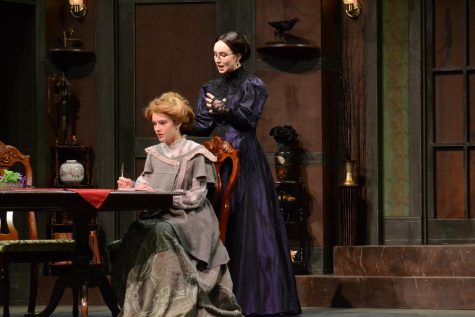
The two sisters Agatha, played by Julia Murray, and Huldey, played by Lillian Ferguson, are opposite people in relation to their character’s personalities. Agatha’s mood fills the room like a secret in desperate need of a listener, while Hudley’s almost child-like excitement and near obsession with Emilie and her arrival characterizes her early on as a young character desperate for something to change in her life. Later it is revealed that Branwell is living in the attic alone and on his death bed, and that the true purpose of Emilie’s arrival is to have the child with him.
The Mastiff, played by Cole Warren, is the family dog, but he delivers soliloquies when around other characters or alone. In these moments, he asks questions of God and about God’s identity. He is a representation of status in the show, but his life takes on introspective challenges that cannot help but evoke emotion from the audience. He is a beast with a kind touch that directly impacts and eventually ends his budding relationship with the moor-hen, played by Amber Bullock. The Mastiff wants to be hands-on, protective, by the moor hen’s side all the time, but the moor-hen desires space and distance.
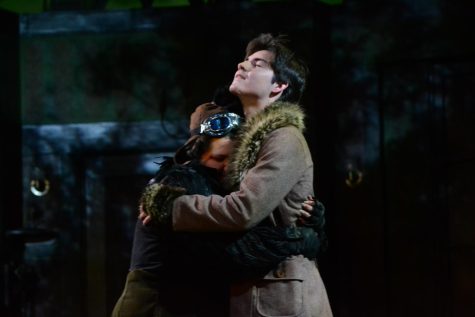
“She’s someone who wants to live in the moment which is where her and the Mastiff kind of clash,” said Bullock. “He’s constantly thinking about the future and what it means for them. However, she just knows that she flies, and she finds food and that’s what she does, that’s what she will always do regardless of the relationship she develops.”
Kathryn Dowdee plays Mallory, Marjory and Margaret. These three are all one character that create a comedic and mischievous persona that is never completely understood. The stage is painted to resemble one room in the house that is called the dining room, Emilie’s bedroom and the parlor. When she’s Mallory, she has the baby, which is played comedically because Mallory is not actually pregnant. When she’s Marjory, she has typhus, but she’s not actually sick, and when she’s an author her name is Margaret. This trifecta paints the picture for the other characters who have deeply rooted desires yet don’t understand how to achieve them due to their lifestyle of isolation and required simplicity.
“The challenging part of playing Marjory, Mallory, and Margaret was the process of dissecting the different personalities of the three and how they connect to each other,” said Dowdee. “Mallory has the class, and she can hold her tongue, Marjory has the angst and the fire, both are smart and are observant. However, Margaret is both Mallory and Marjory. She has the class and the fire, and she won’t give away her plans by slipping up. It was finding out that Margaret shows up much earlier than anyone knows when she starts her plan. This brought me to my ultimate realization of Margaret being the true character among the roles.”
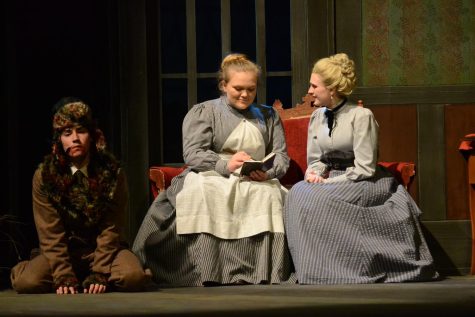
Dowdee’s facial expressions in the show are the baseline for her character. The way she moves slowly and silently across the stage invites the audience to focus on other things while she manipulates the situation to get what she wants. She is the definition of attitude and sass in the show. Her expressions create the mood for the audience as well as for the scene.
Love, humor, philosophy, absurdism and horror are major themes in this show. The uncertainty of time, but more importantly the lack of a concrete definition of time, is a large factor in the show.
“With the show taking place on the moors there is the idea that time moves differently, almost as if the show lives in its own pocket reality,” said Bullock. “Which is why days can be started over or completely ignored, it is also why the house only has one ‘room’, the script does this so that it can better live outside of the realm of normal which is so cool!”
Tamms has other ideas on how time works in the show. “My take on it was that since the moors are so isolated and that there isn’t much to do, time seems to move at its own pace there,” she said. “The characters measure these lengths of time in their own unique ways as well. Everything always seems to take longer than it should, or maybe some things move faster on the moors!”
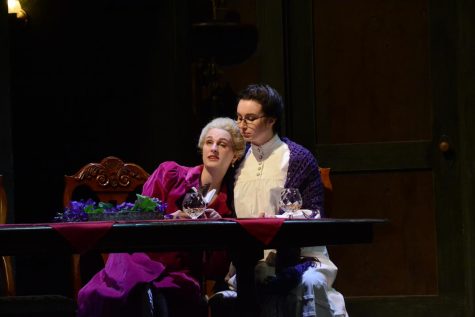
The characters in this show represent an interconnected, somewhat twisted reality of the effects of isolation, obsession and humanity. Each one carries a burden inside them somewhere, but they are loveable all the same. They are all interconnected, not just through family ties, but through the values that come out through their dialogue and their desires that are buried deep inside them, sometimes expressed through violence. Their silent and isolated lifestyles have twisted these characters’ minds and may have trapped them in the moors forever.
“The Moors” is deeply intertwined in the pitfalls and beauty of humanity. It examines isolation, horror, love and comedy. It is the human condition with a twist of impossibly funny hatred and relationships that push the standard ideas of what a relationship should look like. This show is complex and asks questions that cannot help but invite the audience to ponder the concepts of pain, love, anxiety, loss and identity.
This show was incredible and the actors were the key pieces in creating a world that the audience couldn’t help but be invested in. “The Moors” is a must see.
“The Moors” runs from March 31-April 3 and April 7-10. The show begins at 8 p.m. Thursday through Saturday and 2 p.m. on Sunday, with a livestream option.












